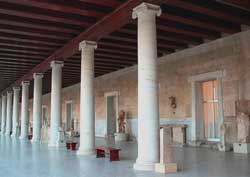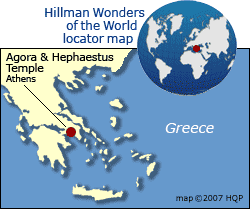Agora & Hephaestus
 Why the
Ancient Agora
and Hephaestus Temple
in Athens are special
Why the
Ancient Agora
and Hephaestus Temple
in Athens are special"Agora" in Greek means "a gathering place". And so it was in Athens and some other cities of Greece. It was the civic center of political, social, intellectual, judicial and commercial life.
The Agora site is visually enhanced by the presence of its neighbor, the Hephaestus Temple.
Agora tips and insights
Socrates
He often sauntered through the Ancient Agora as he lectured Plato and his other students. His life later ended here when he downed the fatal hemlock drink.
Deterioration
He often sauntered through the Ancient Agora as he lectured Plato and his other students. His life later ended here when he downed the fatal hemlock drink.
Excavation
The site lay hidden until it was unearthed in the 1890s during a railroad construction project. When Athenians recognized its historic value, non-Agora structures were torn down and the Ancient Agora was slowly excavated.
Almost all the buildings we see today are flattened ruins, comprised mostly of foundation blocks and floor slabs. One notable exception is the colonnaded Stoa of Attalos (see photo). It was restored in the 1950s. Unfortunately, it was rebuilt in a style that vaguely reminds me of a Las Vegas hotel lobby.
Hephaestus Temple
Setting
The 5th century BC Hephaestus Temple sits on a nearby hill within stone-throwing distance from the Ancient Agora.
Compared with the Parthenon
It is similar in design to the Parthenon (both are Doric-style Greek temples), but noticeably smaller. However, it is in appreciably better condition than its more famous sibling, which makes the Hephaestus Temple one of the must-see attractions of Greece.
More tips and insights
View from the Agora
You get a splendid upward view of the Acropolis from this site.
Athens has two other major agoras
-
Roman Agora
It was built around 15 BC and is now in ruins. - Central Agora
This is a contemporary marketplace selling fresh Greek foods and other products.



